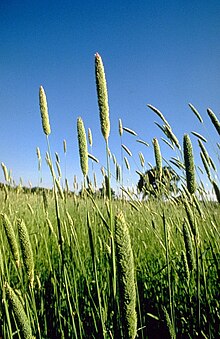Phalaris aquatica
 From Wikipedia the free encyclopedia
From Wikipedia the free encyclopedia
| Phalaris aquatica | |
|---|---|
 | |
| Scientific classification | |
| Kingdom: | Plantae |
| Clade: | Tracheophytes |
| Clade: | Angiosperms |
| Clade: | Monocots |
| Clade: | Commelinids |
| Order: | Poales |
| Family: | Poaceae |
| Subfamily: | Pooideae |
| Genus: | Phalaris |
| Species: | P. aquatica |
| Binomial name | |
| Phalaris aquatica | |
| Synonyms | |
| Phalaris tuberosa | |
Phalaris aquatica, known by the common names bulbous canary-grass[2] and Harding grass, is a species of grass in the genus Phalaris of the family Poaceae.
Description
[edit]It is an erect, waist-high, stout perennial bunch grass, with grayish to bluish green leaves. Flowering heads are dense, spike-like, and usually 2 to 5 inches (50 to 125 mm) long. It is slow to develop from seed, but can form large bunches after several years.[3]
Phalaris arundinacea (reed canary grass) differs from Harding grass in having more distinct rhizomes, and an inflorescence that is compact at first but becomes more open as the branches spread.
Hybrids of Harding grass and reed canary grass have been produced. Varieties include 'AQ1', 'Uneta', and 'Australis'.
P. aquatica is a quick-growing grass which incorporates and utilises soil nitrogen rapidly.[4]: 169–174
Geography
[edit]Phalaris aquatica originated from Southern Europe and the Caucasus. It is naturalized in South Africa, Australia, New Zealand and the USA.[5] Although very recently introduced there, its pasture value was first recognised in Australia.[6] Domesticated cultivation then spread to the United States, Argentina and several other countries in South America, and New Zealand.[6]
Chemical constituents
[edit]Leaves and seedlings contain gramine.[7]
Forage
[edit]Phalaris aquatica is a pasture species grazed by ruminants. The grass can also be cut, providing good quality fodder for grazing livestock for 8 to 12 months a year.[5]
Toxicity
[edit]Some Phalaris species contain gramine, which can cause brain damage, other organ damage, central nervous system damage and death in sheep,[7] although Phalaris aquatica is said to be non-toxic to them.[8]

In Victoria, Australia, it is reported that kangaroos grazing on Phalaris aquatica may develop a condition known familiarly as "Phalaris staggers", in which coordination and mobility are affected.[9]
Invasive species
[edit]Harding grass is an invasive species in grassland, oak woodland, chaparral, and riparian habitats. Native grasses and grassland habitat in California are affected.[citation needed]
References
[edit]- ^ "Phalaris aquatica". Germplasm Resources Information Network. Agricultural Research Service, United States Department of Agriculture. Retrieved 2008-04-02.
- ^ BSBI List 2007 (xls). Botanical Society of Britain and Ireland. Archived from the original (xls) on 2015-06-26. Retrieved 2014-10-17.
- ^ "Phalaris aquatica". California Invasive Plant Council. 2006-02-06. Archived from the original on 2006-02-06. Retrieved 2022-05-03.
- ^ Cheplick, Gregory Paul, ed. (8 August 1995). Written at San Diego, California, USA. Population Biology of Grasses. Annual meeting of the Botanical Society of America. New York: Botanical Society of America (CUP) (published 1998). pp. xii–399. doi:10.1017/CBO9780511525445. ISBN 978-0-511-52544-5. OCLC 847373775.
- ^ a b Heuzé V.; Tran G.; Boudon A.; Lebas F. (2017). "Bulbous canary grass (Phalaris aquatica)". Feedipedia.org.
- ^ a b Oram, R. N.; Ferreira, V.; Culvenor, R. A.; Hopkins, A. A.; Stewart, A. (2009). "The first century of Phalaris aquatica L. cultivation and genetic improvement: a review". Crop & Pasture Science. 60 (1). CSIRO: 1. CiteSeerX 10.1.1.610.2641. doi:10.1071/cp08170. ISSN 1836-0947. S2CID 83767465.
- ^ a b Cheeke, Peter R. (31 August 1989). Toxicants of Plant Origin - Google Book Search. CRC-Press. ISBN 9780849369902. Retrieved 2008-04-20.
- ^ "The Regional Institute - BREEDING NON-TOXIC PHALARIS (PHALARIS AQUATICA L.)". Regional.org.au. 29 November 2012. Retrieved 29 November 2021.
- ^ Printz, Jo; Kearney, Mark (21 June 2018). "Kangaroos under the influence: Grass to blame for staggering death of 'drunken' kangaroos". ABC News. Australian Broadcasting Corporation. Retrieved 29 November 2021.